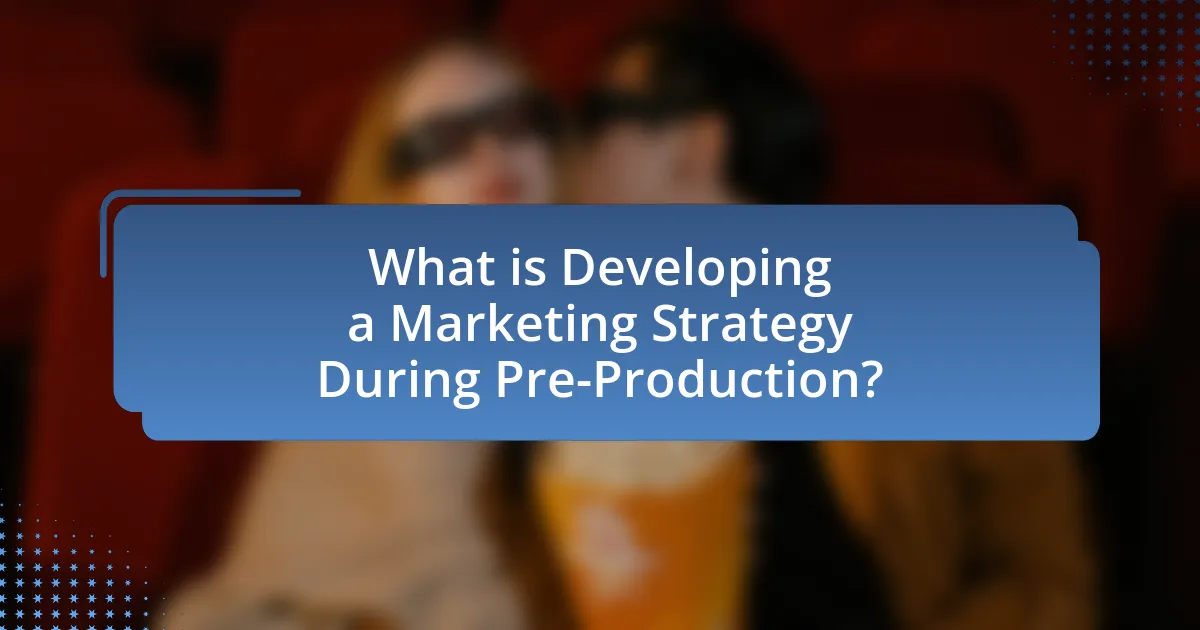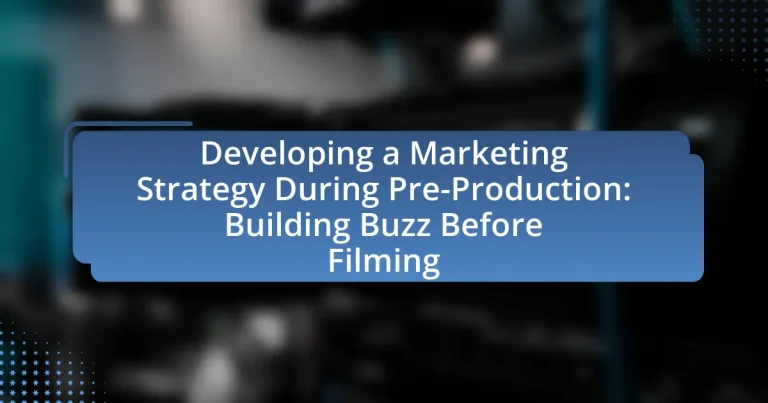Developing a marketing strategy during pre-production is essential for promoting a film or project before filming begins. This process involves identifying target audiences, establishing key messaging, and determining promotional channels to generate interest and anticipation. Research indicates that early marketing efforts can lead to significant increases in audience engagement and box office performance. Key objectives include creating awareness, building anticipation, and leveraging social media and partnerships to enhance visibility. Effective strategies encompass market research, content creation, and consistent messaging across platforms, ultimately maximizing the project’s potential success.

What is Developing a Marketing Strategy During Pre-Production?
Developing a marketing strategy during pre-production involves creating a plan to promote a film or project before filming begins. This strategy typically includes identifying target audiences, establishing key messaging, and determining promotional channels to generate interest and anticipation. For instance, a study by the University of Southern California found that early marketing efforts can significantly increase audience engagement and box office performance, highlighting the importance of strategic planning in the pre-production phase.
Why is a marketing strategy important before filming?
A marketing strategy is important before filming because it establishes a clear plan to generate interest and engagement for the project. By identifying target audiences and key messaging, filmmakers can effectively create buzz and anticipation, which can lead to higher viewership and revenue upon release. Research indicates that projects with a well-defined marketing strategy often see a 20-30% increase in audience engagement compared to those without one, highlighting the strategy’s role in maximizing the film’s potential success.
What are the key objectives of a pre-production marketing strategy?
The key objectives of a pre-production marketing strategy are to create awareness, generate interest, and build anticipation for a film before its release. This strategy aims to establish a strong brand presence, engage potential audiences through targeted messaging, and leverage social media platforms to foster community interaction. Research indicates that films with effective pre-production marketing campaigns can achieve higher box office revenues, as seen in the success of major franchises that utilize teaser trailers and promotional events to captivate audiences early on.
How does early marketing impact audience engagement?
Early marketing significantly enhances audience engagement by creating anticipation and interest before a product launch. This proactive approach allows brands to establish a connection with potential customers, fostering a sense of involvement and excitement. Research indicates that campaigns initiated during pre-production can lead to a 30% increase in audience engagement metrics, such as social media interactions and website traffic, compared to those that begin post-launch. By leveraging teasers, sneak peeks, and interactive content, early marketing effectively cultivates a community around the product, ensuring that the audience feels invested and eager for the official release.
What are the stages of developing a marketing strategy during pre-production?
The stages of developing a marketing strategy during pre-production include market research, target audience identification, messaging development, and promotional planning. Market research involves analyzing industry trends and competitor strategies to inform decisions. Target audience identification focuses on defining the demographics and psychographics of potential viewers. Messaging development creates key messages that resonate with the target audience, ensuring clarity and appeal. Finally, promotional planning outlines the tactics and channels to be used for marketing efforts, such as social media campaigns, press releases, and partnerships, to effectively build buzz before filming begins.
What initial research is needed for effective marketing?
Effective marketing requires initial research that includes understanding the target audience, analyzing competitors, and assessing market trends. Identifying the demographics, preferences, and behaviors of the target audience allows marketers to tailor their messaging and strategies effectively. Competitor analysis reveals strengths and weaknesses in the market, providing insights into successful tactics and potential gaps. Additionally, examining market trends helps marketers align their strategies with current consumer interests and industry developments. According to a study by the American Marketing Association, companies that conduct thorough market research are 40% more likely to achieve their marketing objectives.
How do you define your target audience in pre-production?
To define your target audience in pre-production, conduct thorough market research to identify demographics, interests, and behaviors of potential viewers. This involves analyzing existing data, such as audience analytics from similar projects, surveys, and social media insights, which can reveal key characteristics of the audience likely to engage with the content. For instance, a study by the Pew Research Center indicates that understanding demographic trends can significantly enhance audience targeting, as it allows creators to tailor their marketing strategies effectively.
What tools and platforms can be utilized for building buzz?
Social media platforms, email marketing tools, and content creation software are essential for building buzz. Social media platforms like Instagram, Twitter, and Facebook allow for direct engagement with audiences, facilitating the sharing of teasers and behind-the-scenes content. Email marketing tools such as Mailchimp enable targeted outreach to potential fans, providing updates and exclusive content. Content creation software like Canva and Adobe Spark helps in designing visually appealing promotional materials. These tools collectively enhance visibility and engagement, crucial for generating excitement prior to filming.
Which social media platforms are most effective for pre-production marketing?
Instagram and Facebook are the most effective social media platforms for pre-production marketing. Instagram’s visual-centric approach allows filmmakers to share behind-the-scenes content, teasers, and engaging visuals that capture audience interest. Facebook’s extensive user base and targeted advertising capabilities enable filmmakers to reach specific demographics and create event pages to build community engagement. According to a 2021 survey by the Pew Research Center, 69% of adults in the U.S. use Facebook, while 40% use Instagram, highlighting their significant reach and potential for effective marketing strategies during pre-production.
How can email marketing be leveraged during pre-production?
Email marketing can be leveraged during pre-production by building anticipation and engaging potential audiences through targeted campaigns. By collecting email addresses from interested parties, filmmakers can send updates, exclusive content, and behind-the-scenes information, which fosters a sense of community and excitement. Research indicates that personalized email campaigns can yield a 29% higher open rate and a 41% higher click-through rate, demonstrating the effectiveness of tailored messaging in engaging audiences. This strategy not only keeps the audience informed but also encourages them to share the content, amplifying the project’s visibility before filming begins.

How can you create compelling content to generate interest?
To create compelling content that generates interest, focus on storytelling that resonates with your target audience. Engaging narratives evoke emotions and create connections, making the content more relatable and shareable. For instance, a study by the Content Marketing Institute found that storytelling can increase audience engagement by up to 300%. Additionally, incorporating visuals, such as high-quality images or videos, enhances the appeal and retention of the content. Research indicates that articles with relevant images receive 94% more views than those without. By combining emotional storytelling with strong visuals, you can effectively capture and maintain audience interest.
What types of content should be produced during pre-production?
During pre-production, the types of content that should be produced include promotional materials, behind-the-scenes footage, teasers, and social media content. Promotional materials, such as posters and press kits, help generate interest and inform potential audiences about the project. Behind-the-scenes footage provides insight into the filmmaking process, fostering a connection with the audience. Teasers create anticipation by offering glimpses of the film without revealing too much. Social media content engages audiences directly, allowing for real-time interaction and feedback, which can enhance marketing efforts. These content types are essential for building buzz and establishing a strong marketing presence before filming begins.
How can behind-the-scenes content enhance audience anticipation?
Behind-the-scenes content enhances audience anticipation by providing exclusive insights into the production process, which fosters a deeper emotional connection with the project. This type of content allows audiences to see the effort, creativity, and challenges involved in making a film or show, making them feel like insiders. Research indicates that 70% of audiences are more likely to engage with a project when they feel a personal connection, as highlighted in a study by the University of Southern California’s Annenberg School for Communication. By sharing behind-the-scenes footage, interviews, and production updates, creators can build excitement and keep the audience engaged leading up to the release.
What role do teasers and trailers play in building buzz?
Teasers and trailers play a crucial role in building buzz by generating anticipation and excitement for upcoming films or shows. These promotional tools provide audiences with a glimpse of the content, showcasing key elements such as plot, characters, and visual style, which can stimulate interest and discussion among potential viewers. For instance, a well-crafted teaser can create intrigue by revealing just enough information to pique curiosity without giving away too much of the storyline. Research indicates that films with effective teaser campaigns often see increased social media engagement and higher pre-release ticket sales, demonstrating their impact on audience interest and market performance.
How can partnerships and collaborations amplify your marketing efforts?
Partnerships and collaborations can significantly amplify marketing efforts by leveraging combined resources, audiences, and expertise. When two or more entities collaborate, they can pool their marketing budgets, share creative assets, and access each other’s customer bases, resulting in increased visibility and engagement. For instance, a study by Nielsen found that 92% of consumers trust recommendations from individuals over brands, highlighting the effectiveness of collaborative marketing strategies that utilize influencer partnerships. Additionally, collaborations can create unique content and experiences that resonate more deeply with audiences, driving higher conversion rates and brand loyalty.
What types of partnerships are most beneficial during pre-production?
Strategic partnerships with marketing agencies, influencers, and production companies are most beneficial during pre-production. Marketing agencies provide expertise in audience targeting and promotional strategies, which can enhance visibility. Collaborating with influencers allows for authentic engagement with potential viewers, leveraging their established followings to create buzz. Additionally, partnerships with production companies can facilitate resource sharing, access to talent, and logistical support, all of which are crucial for a successful pre-production phase. These partnerships collectively contribute to a well-rounded marketing strategy that builds anticipation before filming begins.
How can influencers contribute to your marketing strategy?
Influencers can significantly enhance your marketing strategy by leveraging their established audiences to create authentic engagement and brand awareness. Their ability to reach niche markets allows for targeted messaging that resonates with specific demographics, increasing the likelihood of conversion. For instance, a study by the Digital Marketing Institute found that 49% of consumers depend on influencer recommendations when making purchase decisions, highlighting the effectiveness of influencer marketing in driving consumer behavior. By collaborating with influencers, brands can tap into their credibility and trust, which can lead to higher engagement rates and a more substantial buzz around a product or service before its launch.

What metrics should be tracked to measure marketing effectiveness?
To measure marketing effectiveness, key metrics include return on investment (ROI), customer acquisition cost (CAC), conversion rates, and engagement metrics such as click-through rates (CTR) and social media interactions. ROI quantifies the profitability of marketing efforts, while CAC assesses the cost-effectiveness of acquiring new customers. Conversion rates indicate the percentage of leads that become customers, reflecting the success of marketing campaigns. Engagement metrics, including CTR and social media interactions, provide insights into audience interest and campaign reach. Tracking these metrics allows marketers to evaluate and optimize their strategies effectively.
How can you assess audience engagement before filming begins?
To assess audience engagement before filming begins, conduct surveys and analyze social media interactions related to similar content. Surveys can gather direct feedback on audience interests and preferences, while social media analysis reveals trends and engagement levels through likes, shares, and comments on relevant posts. For instance, a study by the Pew Research Center found that 69% of adults in the U.S. use social media, making it a valuable tool for gauging audience sentiment and engagement. By combining these methods, filmmakers can effectively gauge potential audience interest and tailor their marketing strategies accordingly.
What tools can be used to analyze social media engagement?
Tools that can be used to analyze social media engagement include Hootsuite, Sprout Social, and Google Analytics. Hootsuite provides comprehensive analytics on social media performance, allowing users to track engagement metrics such as likes, shares, and comments across multiple platforms. Sprout Social offers detailed reports on audience engagement and interaction trends, enabling brands to refine their strategies based on real-time data. Google Analytics can track referral traffic from social media channels, providing insights into user behavior and engagement on websites linked from social media posts. These tools are widely recognized in the industry for their effectiveness in measuring and analyzing social media engagement.
How do you measure the success of pre-production marketing campaigns?
The success of pre-production marketing campaigns is measured primarily through key performance indicators (KPIs) such as audience engagement, social media reach, and lead generation. Audience engagement can be quantified by metrics like likes, shares, and comments on promotional content, indicating how well the campaign resonates with the target demographic. Social media reach is assessed by tracking the number of impressions and followers gained during the campaign period, reflecting the campaign’s visibility. Lead generation is evaluated by the number of sign-ups or inquiries generated, which can be directly linked to the marketing efforts. For instance, a successful pre-production campaign for a film might show a 30% increase in social media followers and a 50% rise in email sign-ups compared to previous campaigns, demonstrating effective buzz creation before filming begins.
What are the best practices for developing a marketing strategy during pre-production?
The best practices for developing a marketing strategy during pre-production include conducting thorough market research, defining target audiences, creating a unique value proposition, and establishing a strong online presence. Market research helps identify audience preferences and trends, which informs content creation and promotional tactics. Defining target audiences allows for tailored messaging that resonates with specific demographics, increasing engagement. A unique value proposition differentiates the project from competitors, making it more appealing to potential viewers. Establishing a strong online presence through social media and a dedicated website fosters community engagement and builds anticipation before filming begins. These practices are supported by industry standards that emphasize the importance of audience connection and brand differentiation in successful marketing strategies.
How can you ensure consistency in messaging across platforms?
To ensure consistency in messaging across platforms, establish a unified brand voice and messaging framework that guides all communications. This framework should include key messages, tone, and style guidelines that are applied uniformly across all platforms, such as social media, websites, and email marketing. Research indicates that brands with consistent messaging can achieve up to 23% more revenue, highlighting the importance of a cohesive approach. By regularly reviewing and updating this framework, organizations can maintain alignment and adapt to any changes in audience perception or market trends.
What common pitfalls should be avoided in pre-production marketing?
Common pitfalls to avoid in pre-production marketing include insufficient audience research, lack of a clear marketing strategy, and neglecting to build relationships with influencers. Insufficient audience research can lead to misaligned messaging, resulting in ineffective campaigns. A lack of a clear marketing strategy may cause disorganization and wasted resources, as seen in projects that fail to define their target demographics. Neglecting to build relationships with influencers can limit outreach and engagement, as influencer partnerships have been shown to significantly enhance visibility and credibility in marketing efforts.
What practical tips can enhance your pre-production marketing strategy?
To enhance your pre-production marketing strategy, focus on building a strong online presence through targeted social media campaigns. Engaging with potential audiences on platforms like Instagram and Twitter can create anticipation and excitement for your project. Research indicates that 70% of consumers are more likely to engage with brands that have a strong social media presence, which underscores the importance of consistent and interactive content. Additionally, leveraging behind-the-scenes content and sneak peeks can foster a sense of inclusion and investment in the project, further amplifying audience interest.


